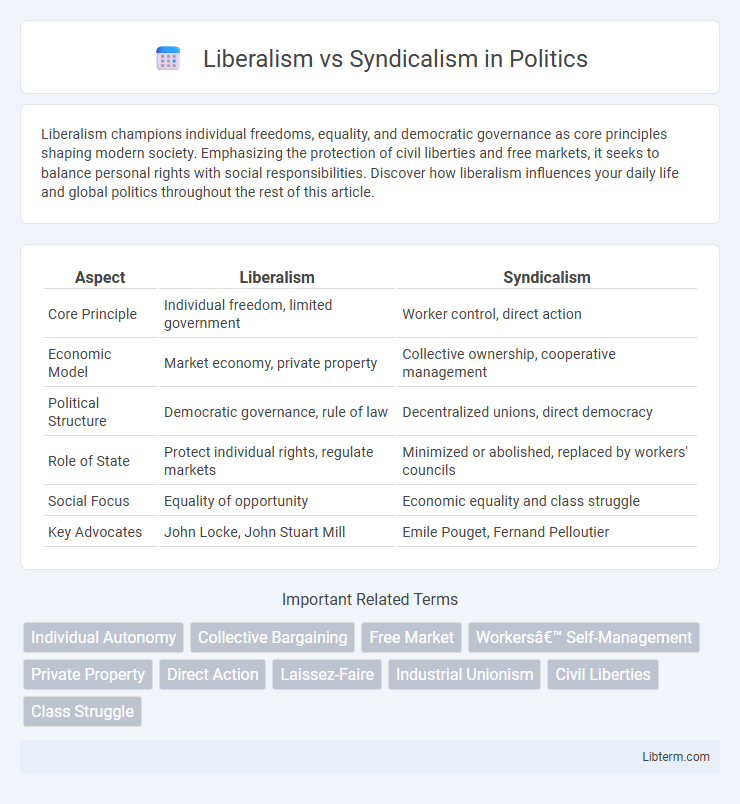Liberalism champions individual freedoms, equality, and democratic governance as core principles shaping modern society. Emphasizing the protection of civil liberties and free markets, it seeks to balance personal rights with social responsibilities. Discover how liberalism influences your daily life and global politics throughout the rest of this article.
Table of Comparison
| Aspect | Liberalism | Syndicalism |
|---|---|---|
| Core Principle | Individual freedom, limited government | Worker control, direct action |
| Economic Model | Market economy, private property | Collective ownership, cooperative management |
| Political Structure | Democratic governance, rule of law | Decentralized unions, direct democracy |
| Role of State | Protect individual rights, regulate markets | Minimized or abolished, replaced by workers' councils |
| Social Focus | Equality of opportunity | Economic equality and class struggle |
| Key Advocates | John Locke, John Stuart Mill | Emile Pouget, Fernand Pelloutier |
Introduction to Liberalism and Syndicalism
Liberalism emphasizes individual rights, free markets, and limited government intervention to promote personal freedom and economic growth, rooted in Enlightenment principles such as equality and rationality. Syndicalism advocates for direct worker control over industries through trade unions and revolutionary action, aiming to dismantle capitalist structures and establish a classless society based on cooperative ownership. These ideologies diverge fundamentally on the role of the state and markets, with liberalism supporting regulated capitalism and syndicalism prioritizing collective worker empowerment.
Historical Origins of Liberalism
Liberalism originated in the Enlightenment era of the 17th and 18th centuries, emphasizing individual liberty, private property, and limited government intervention. Key philosophers such as John Locke and Adam Smith laid the intellectual foundations by advocating for natural rights, free markets, and the rule of law. This political ideology emerged as a response to absolute monarchy and mercantilism, promoting constitutionalism and economic freedom.
Historical Development of Syndicalism
Syndicalism emerged in the late 19th and early 20th centuries as a radical labor movement advocating direct action and workers' control of production, contrasting sharply with liberalism's emphasis on individual rights and free markets. Rooted in the Industrial Revolution's harsh working conditions, syndicalist organizations like the French Confederation generale du travail (CGT) promoted strikes and workplace democracy to achieve economic equality. This historical development positioned syndicalism as a powerful force opposing both capitalist liberalism and centralized state socialism during crucial labor struggles across Europe.
Core Principles of Liberalism
Liberalism centers on individual rights, private property, and free markets, advocating limited government intervention to protect personal freedoms and economic liberties. It emphasizes rule of law, equality before the law, and democratic governance as foundations for social order and political stability. Unlike syndicalism, which prioritizes collective worker control and direct action, liberalism upholds individualism and market-driven economic systems.
Fundamental Tenets of Syndicalism
Syndicalism centers on worker control of the means of production through direct action methods such as strikes and workplace occupations, emphasizing decentralized, industrial unionism and the abolition of capitalism. It opposes liberalism's focus on individual rights and private property by advocating collective ownership and economic democracy. Syndicalism promotes self-management and solidarity among workers as a means to achieve social and economic equality.
Economic Approaches: Markets vs. Worker Control
Liberalism emphasizes free markets, private property, and minimal government intervention to foster economic growth and individual entrepreneurship. Syndicalism advocates for worker control of production through trade unions and cooperative management, aiming to replace capitalist market mechanisms with collective decision-making. These contrasting economic approaches highlight the liberal focus on market-driven efficiency versus syndicalist prioritization of democratic workplace authority and social ownership.
Political Organization and Governance
Liberalism emphasizes individual rights, private property, and representative democracy with a focus on limiting government intervention to protect personal freedoms and market economies. Syndicalism advocates for direct control of industries by worker unions through decentralized, federated councils, promoting collective ownership and decision-making to dismantle capitalist hierarchies. Governance in liberalism centers on constitutional frameworks and elected officials, whereas syndicalism relies on grassroots, democratic worker assemblies to manage political and economic structures.
Social Justice and Individual Rights
Liberalism emphasizes individual rights as the foundation of social justice, advocating for equal legal protections and personal freedoms to ensure fairness in society. Syndicalism prioritizes collective ownership and worker control, viewing social justice through the lens of economic equality and direct action to dismantle capitalist structures. The tension between these ideologies centers on balancing personal liberty with collective empowerment to achieve equitable social outcomes.
Modern Relevance and Real-World Examples
Liberalism emphasizes individual rights, free markets, and limited government intervention, which remains foundational in contemporary democracies such as the United States and Western Europe, promoting economic innovation and personal freedom. Syndicalism advocates for workers' direct control over production through unions and federations, influencing modern labor movements and cooperative enterprises seen in countries like Spain with the Confederacion Nacional del Trabajo (CNT). The contrasting approaches highlight ongoing debates about economic equity and the balance between market freedom and collective worker empowerment in the 21st century.
Conclusion: Contrasts and Implications
Liberalism emphasizes individual freedoms, market economy, and limited government intervention, aiming to create societies based on personal rights and private property. Syndicalism advocates for worker-controlled industries through direct action and collective ownership, prioritizing social equality and economic democracy over individual profit. The contrast between these ideologies reveals fundamental differences in economic organization and political power, impacting debates on labor rights, economic justice, and governance models worldwide.
Liberalism Infographic

 libterm.com
libterm.com